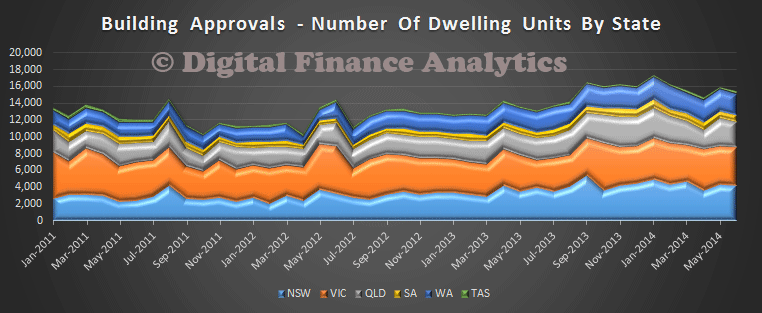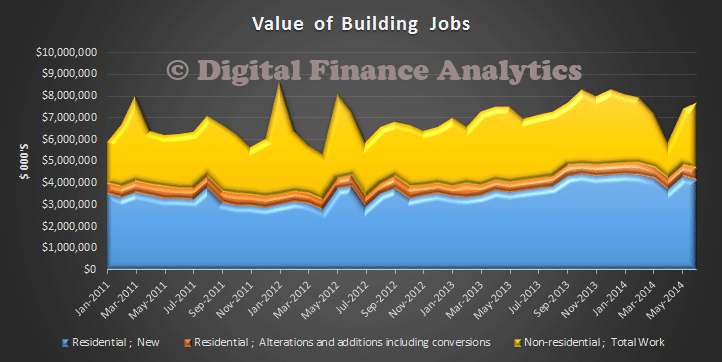The ABS published their data today on Building Approvals to June 2014. The number of dwellings approved fell 1.1 per cent in June 2014, in trend terms, and has fallen for six months. The seasonally adjusted estimate for total dwellings approved fell 5.0% in June following a rise of 10.3% in the previous month. The seasonally adjusted estimate for private sector houses fell 2.2% in June following a rise of 1.4% in the previous month. The seasonally adjusted estimate for private sector dwellings excluding houses fell 10.5% in June following a rise of 26.7% in the previous month. Clearly the data is volatile month by month, so the trend series tells is more about what is happening. Overall, in seasonally adjusted terms, numbers are down, compared with the peak in January 2014.

Dwelling approvals decreased in trend terms in the Australian Capital Territory (15.2 per cent), New South Wales (1.8 per cent), Victoria (0.8 per cent), South Australia (0.7 per cent), Western Australia (0.7 per cent) and Queensland (0.4 per cent) but increased in the Northern Territory (9.2 per cent) and Tasmania (2.7 per cent). In trend terms, approvals for private sector houses fell 0.4 per cent in June. Private sector house approvals fell in trend terms in South Australia (3.7 per cent), New South Wales (0.6 per cent), Western Australia (0.4 per cent) and Victoria (0.2 per cent), but rose in Queensland (0.3 per cent).
The value of total building approved fell 2.6 per cent in June, in trend terms, and has fallen for seven months. The value of residential building fell 0.5 per cent, while non-residential building fell 7.1 per cent in trend terms. The seasonally adjusted estimate of the value of total building approved rose 3.7% in June and has risen for two months. The value of residential building fell 3.7% following a rise of 14.7%. The value of non-residential building rose 17.9% and has risen for two months.
 Continued signs that low interest rates are not translating to strong growth in construction. We still are not building enough properties to meet demand, so expect house prices to continue to rise in some areas at least.
Continued signs that low interest rates are not translating to strong growth in construction. We still are not building enough properties to meet demand, so expect house prices to continue to rise in some areas at least.
